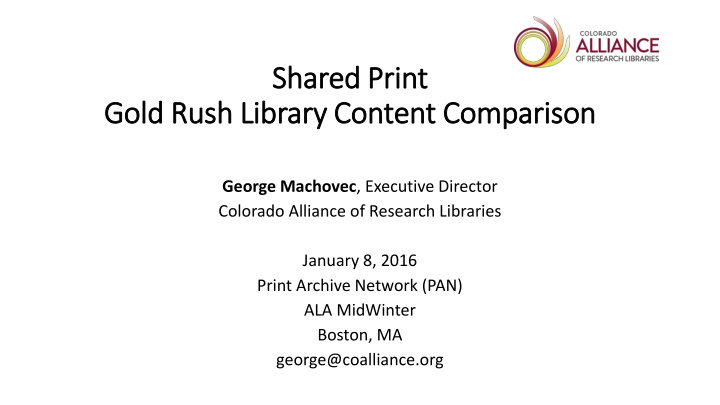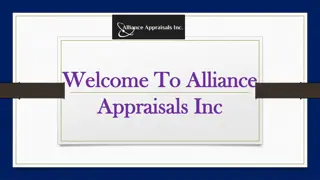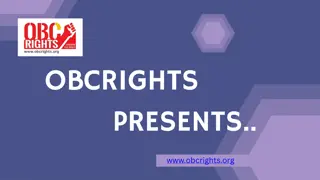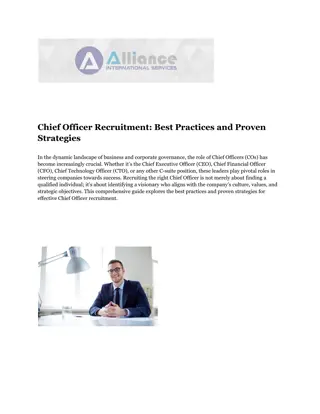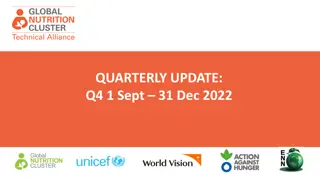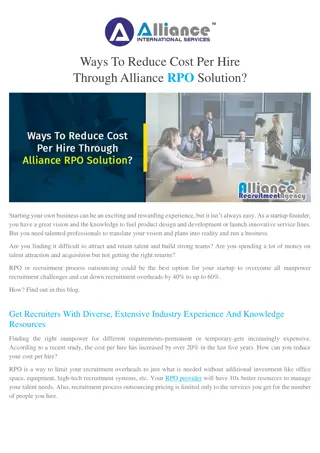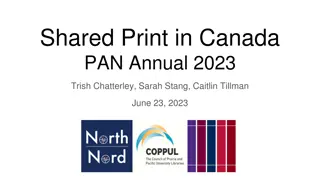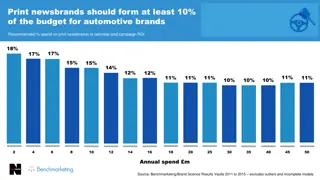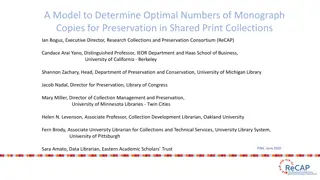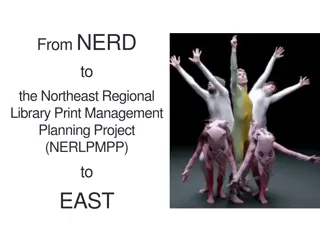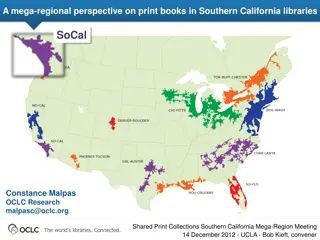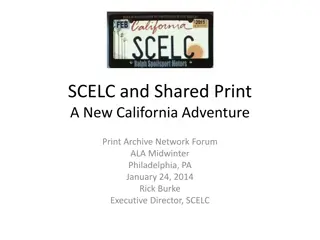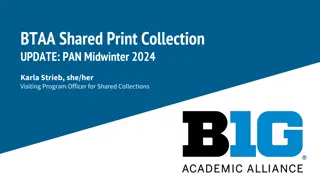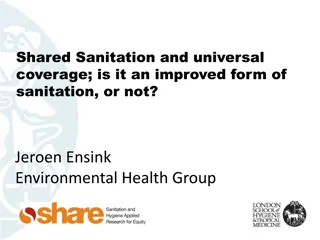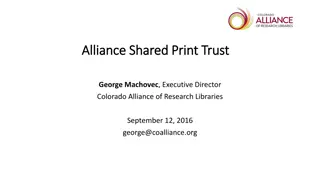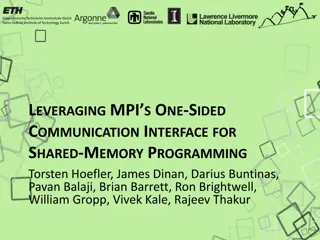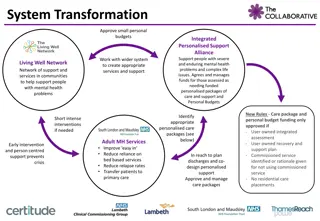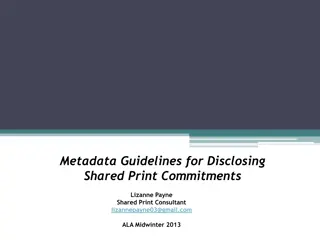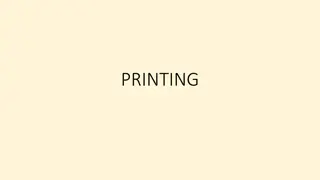Alliance Shared Print Program Overview
Colorado Alliance of Research Libraries established the Alliance Shared Print program focusing on distributed print repositories. The program allows libraries to voluntarily participate, maintain their holdings, and retain materials on behalf of the group. Key features include flexibility, no central shared storage facility, and a Memorandum of Understanding for a 25-year commitment reviewed every five years.
Download Presentation

Please find below an Image/Link to download the presentation.
The content on the website is provided AS IS for your information and personal use only. It may not be sold, licensed, or shared on other websites without obtaining consent from the author.If you encounter any issues during the download, it is possible that the publisher has removed the file from their server.
You are allowed to download the files provided on this website for personal or commercial use, subject to the condition that they are used lawfully. All files are the property of their respective owners.
The content on the website is provided AS IS for your information and personal use only. It may not be sold, licensed, or shared on other websites without obtaining consent from the author.
E N D
Presentation Transcript
Shared Print Shared Print Gold Rush Library Content Comparison Gold Rush Library Content Comparison George Machovec, Executive Director Colorado Alliance of Research Libraries January 8, 2016 Print Archive Network (PAN) ALA MidWinter Boston, MA george@coalliance.org
Colorado Alliance of Research Libraries Incorporated in 1981 14 member libraries (13 academic, 1 public) one out of state library (University of Wyoming) Programs include E-resource licensing 250 contracts (>$14 million) Prospector union catalog 44 libraries, 13.5+ million unique MARC records Gold Rush (ERMS, link resolver, content comparison) Shared Print (launching 2015) A history of innovation and software development
Why another shared print program? Regional focus Running out of room in our libraries and storage facilities Several renovation projects underway Strong resource sharing network Prospector union catalog Ever greater reliance on ebooks Several storage facilities in the state
Key Features Distributed No attempt to build a single journal run No central shared storage facility shared by all although a shared storage facility for 4 CU campuses exists Each library maintains holdings Voluntary Libraries can participate as much or as little as they wish No one is ever forced to keep or discard a volume Flexible Can expand as needed Allows libraries to participate in other programs
Memorandum of Understanding Signed by participating institutions But every institution benefits Can bring in non-Alliance partners as needed Establishes the Alliance Shared Print Trust Distributed print repository Participants agree to retain materials on behalf of the group and disclose retention decisions Provides a framework for specific projects, which can be established as needed 25-year commitment, reviewed every five years
Shared Print Program Alliance Shared Print Trust Agreements Broad agreement (MOU) signed by participating libraries Circulating monographs policy, Serials policy, Disclosure policy An analysis tool was needed that was affordable and flexible Commercial tools (Intota Assessment, OCLC Collection Evaluation, SCS Greenglass for Groups) are excellent services but were too expensive for member libraries
Comparison Tool Selected Characteristics Must be scalable to work from the smallest to largest libraries Must work in real-time Must support comparing any combination of libraries (1-1, 1-many, many- many) Must support export of MARC, XML and delimited (Excel) Must show what s unique and overlapping, including visualizations Must be able to have searches or facets to work with any fields in a MARC record Matching algorithm must be made from elements in a MARC record but NOT depend on OCLC #, ISBN, ISSN Must be easy-to-use!
Elements in Match Key Title Publication Year 260 or 264 $c Pagination 300 $a Edition Statement 250 $a Publisher Name 260 or 264 $b Additional programming for cartographic and sudocs 245 $a $b General Media Description 245 $h Type of '_' Leader Title Part 245 $p Title Number 245 $n
Technology Linux (CentOS) Play web application framework SOLR (developing SOLR RDF) no SQL Open source charting software All virtualized on multiple VMs Google MARC ingest (from the Google Books Project) Must be scalable to hundreds of millions of records working in real-time
Loading and updating System is ILS agnostic Records can be done as often as you want but no more than once per day Suggested that full database updates be done monthly (unless a big change occurs and then it can be done on-demand) No deletes, at the present, so full updates are needed when many records are removed from your local catalog SFTP (secure FTP) is used to deposit records in either a full or updates directory
Source of MARC records Prefer a direct export from your ILS rather than a union catalog export Challenges with union catalog (INN-Reach) metadata Nobody contributes all MARC records The master record may not always be yours Libraries prefer getting their own records back rather than a generic MARC record from the union catalog A local export will eventually be need for item and/or circ data But the Prospector union catalog was perfect for development and scaling
Simple comparison of two large academic libraries with no special limiting. Each with greater than 4 million records. University of Colorado vs. University of Wyoming At this level mostly useful for bragging rights!
Same two libraries but limited to the last five years. Showing which library is currently doing better in growing their collection.
Can save searches and export records in MARC, XML and delimited formats Same two libraries but limited to astrophysics materials added in last 5 years.
University of Colorado at Boulder compared to 25 other libraries with no limiters! Comparing 4.6 million MARC records to almost 12 million MARC records in seconds
Challenges Faced in the Project Making the user interface (UI) easy and intuitive Getting the matching algorithm right Too tight we end up with too many orphans that should have matched Too loose we end up with false merges Sometimes libraries want e-resources to match with print and sometimes they don t This will likely keep changing as it will continue to be refined Making it all happen in real-time and scalable to any library size (accomplished)
Work Yet to be Done Interest in adding additional datasets such as HathiTrust public domain items, commercial ebook sets, etc. Adding branch level metadata for doing comparisons within a library system (particularly important for public libraries) Incorporating circ data Looking at overlap for how many owning libraries (right now it s binary is something unique or owned by more than one) Adding new facets as requested by users Conspectus type analysis call number range analysis Not doing gap analysis for serials (although serials loaded for title-level comparisons)
Sample Use Cases Shared print programs What to put in storage What to weed Getting a set of unique records and adding a 583 retention note Adding a new program on campus and want to compare holdings with an established institution with the same program Compare a consideration pool (e.g. weeding or storage) to others Want to compare branches in a public library system Comparing collection with commercial datasets or other catalogs (e.g. HathiTrust, CRL) Quick exports for participation in other cooperative programs Bragging or complaining with your colleagues or administration!
Whats Next for the System? Getting direct loads from all of the Prospector (union catalog) libraries to replace the union catalog records Adding features of interest to participants we are in control! Gearing up the infrastructure Optimizing many aspects of the system Comparison speeds Loading speeds Better fault tolerance for bad metadata
Next Steps Next Steps Promote the use of the content comparison tool (we will make it available to others outside of our region for a small annual fee) Build on existing programs of study and institutional collection strengths Coordinate monograph approval plans and purchasing of print monographs enough copies, but not too many Purchase at least one copy of a print monograph for selected publishers and/or subjects
Questions? George Machovec Executive Director Colorado Alliance of Research Libraries george@coalliance.org
